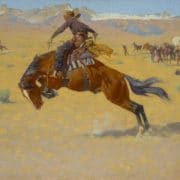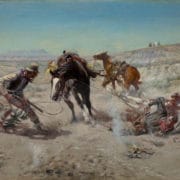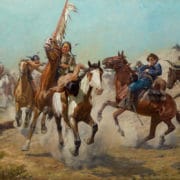Interpreters of the Old West
Explore the works discussed in the video below. Click the thumbnails to expand.
The modern West rapidly took shape in the decades after the Civil War. The completion of the transcontinental railroad hastened settlement and urbanization as well as the confinement of Plains Indians to reservations. However, the close of the frontier only intensified the public’s love affair with the heroic characters and unspoiled beauty of the Old West. An endless stream of dime novels, adventure stories published in illustrated papers and magazines such as Harper’s Weekly, Collier’s, and Field and Stream, and popular spectacles like Buffalo Bill’s Wild West testified to the lasting importance of the West in the American imagination. Frederic Remington, a New Yorker educated at Yale, was the greatest of the western painters and illustrators of the late 19th century. Remington reduced frontier action to its purest form; his iconic images resonate with both the triumph and tragedy of American western history. Like Frederic Remington, Charles M. Russell witnessed the last days of the Old West, but he did so from the perspective of a Montana horse wrangler rather than a sophisticated traveler from the East. Russell excelled with figures and horses in complex motion—and often on the verge of disaster. Charles Schreyvogel made his first trip west several years after the end of the Plains Indian Wars. By interviewing cavalry officers and other veterans of those conflicts, Schreyvogel became their premier visual historian.
| ← California Painters | Golden Age of Illustration → |
| Return to the Anschutz Collection | |






